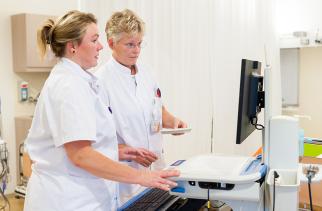Coordinator research program Professions in Healthcare and Manpower Planning; endowed professor 'Health workforce and organisation studies', Radboud University, the Netherlands
Publicatie
Publication date
International comparison of professional competency frameworks for nurses: a document analysis.
Wit, R.F., Veer, A.J.E. de, Batenburg, R.S., Francke, A.L. International comparison of professional competency frameworks for nurses: a document analysis. BMC Nursing: 2023, 22, p. Art. nr. 343.
Read online
Background
Nursing competency frameworks describe the competencies; knowledge, skills and attitudes nurses should possess. Countries have their own framework. Knowledge of the content of professional competency frameworks in different countries can enhance the development of these frameworks and international collaborations.
Objective
This study examines how competencies and task divisions are described in the current professional competency frameworks for registered nurses (RNs with a Bachelor’s degree) in the Netherlands, Belgium, the United Kingdom (UK), Canada and the United States (US).
Methods
Qualitative document analysis was conducted using the most recently published professional competency frameworks for registered nurses in the above-mentioned five countries.
Results
All the competency frameworks distinguished categories of competencies. Three of the five frameworks explicitly mentioned the basis for the categorization: an adaptation of the CanMEDS model (Netherlands), European directives on the recognition of professional qualifications (Belgium) and an adapted inter-professional framework (US). Although there was variation in how competencies were grouped, we inductively identified ten generic competency domains: (1) Professional Attitude, (2) Clinical Care in Practice, (3) Communication and Collaboration, (4) Health Promotion and Prevention, (5) Organization and Planning of Care, (6) Leadership, (7) Quality and Safety of Care, (8) Training and (continuing) Education, (9) Technology and e-Health, (10) Support of Self-Management and Patient Empowerment. Country differences were found in some more specific competency descriptions. All frameworks described aspects related to the division of tasks between nurses on the one hand and physicians and other healthcare professionals on the other hand. However, these descriptions were rather limited and often imprecise.
Conclusions
Although ten generic domains could be identified when analysing and comparing the competency frameworks, there are country differences in the categorizations and the details of the competencies described in the frameworks. These differences and the limited attention paid to the division of tasks might lead to cross-country differences in nursing practice and barriers to the international labour mobility of Bachelor-educated RNs.
Nursing competency frameworks describe the competencies; knowledge, skills and attitudes nurses should possess. Countries have their own framework. Knowledge of the content of professional competency frameworks in different countries can enhance the development of these frameworks and international collaborations.
Objective
This study examines how competencies and task divisions are described in the current professional competency frameworks for registered nurses (RNs with a Bachelor’s degree) in the Netherlands, Belgium, the United Kingdom (UK), Canada and the United States (US).
Methods
Qualitative document analysis was conducted using the most recently published professional competency frameworks for registered nurses in the above-mentioned five countries.
Results
All the competency frameworks distinguished categories of competencies. Three of the five frameworks explicitly mentioned the basis for the categorization: an adaptation of the CanMEDS model (Netherlands), European directives on the recognition of professional qualifications (Belgium) and an adapted inter-professional framework (US). Although there was variation in how competencies were grouped, we inductively identified ten generic competency domains: (1) Professional Attitude, (2) Clinical Care in Practice, (3) Communication and Collaboration, (4) Health Promotion and Prevention, (5) Organization and Planning of Care, (6) Leadership, (7) Quality and Safety of Care, (8) Training and (continuing) Education, (9) Technology and e-Health, (10) Support of Self-Management and Patient Empowerment. Country differences were found in some more specific competency descriptions. All frameworks described aspects related to the division of tasks between nurses on the one hand and physicians and other healthcare professionals on the other hand. However, these descriptions were rather limited and often imprecise.
Conclusions
Although ten generic domains could be identified when analysing and comparing the competency frameworks, there are country differences in the categorizations and the details of the competencies described in the frameworks. These differences and the limited attention paid to the division of tasks might lead to cross-country differences in nursing practice and barriers to the international labour mobility of Bachelor-educated RNs.
Background
Nursing competency frameworks describe the competencies; knowledge, skills and attitudes nurses should possess. Countries have their own framework. Knowledge of the content of professional competency frameworks in different countries can enhance the development of these frameworks and international collaborations.
Objective
This study examines how competencies and task divisions are described in the current professional competency frameworks for registered nurses (RNs with a Bachelor’s degree) in the Netherlands, Belgium, the United Kingdom (UK), Canada and the United States (US).
Methods
Qualitative document analysis was conducted using the most recently published professional competency frameworks for registered nurses in the above-mentioned five countries.
Results
All the competency frameworks distinguished categories of competencies. Three of the five frameworks explicitly mentioned the basis for the categorization: an adaptation of the CanMEDS model (Netherlands), European directives on the recognition of professional qualifications (Belgium) and an adapted inter-professional framework (US). Although there was variation in how competencies were grouped, we inductively identified ten generic competency domains: (1) Professional Attitude, (2) Clinical Care in Practice, (3) Communication and Collaboration, (4) Health Promotion and Prevention, (5) Organization and Planning of Care, (6) Leadership, (7) Quality and Safety of Care, (8) Training and (continuing) Education, (9) Technology and e-Health, (10) Support of Self-Management and Patient Empowerment. Country differences were found in some more specific competency descriptions. All frameworks described aspects related to the division of tasks between nurses on the one hand and physicians and other healthcare professionals on the other hand. However, these descriptions were rather limited and often imprecise.
Conclusions
Although ten generic domains could be identified when analysing and comparing the competency frameworks, there are country differences in the categorizations and the details of the competencies described in the frameworks. These differences and the limited attention paid to the division of tasks might lead to cross-country differences in nursing practice and barriers to the international labour mobility of Bachelor-educated RNs.
Nursing competency frameworks describe the competencies; knowledge, skills and attitudes nurses should possess. Countries have their own framework. Knowledge of the content of professional competency frameworks in different countries can enhance the development of these frameworks and international collaborations.
Objective
This study examines how competencies and task divisions are described in the current professional competency frameworks for registered nurses (RNs with a Bachelor’s degree) in the Netherlands, Belgium, the United Kingdom (UK), Canada and the United States (US).
Methods
Qualitative document analysis was conducted using the most recently published professional competency frameworks for registered nurses in the above-mentioned five countries.
Results
All the competency frameworks distinguished categories of competencies. Three of the five frameworks explicitly mentioned the basis for the categorization: an adaptation of the CanMEDS model (Netherlands), European directives on the recognition of professional qualifications (Belgium) and an adapted inter-professional framework (US). Although there was variation in how competencies were grouped, we inductively identified ten generic competency domains: (1) Professional Attitude, (2) Clinical Care in Practice, (3) Communication and Collaboration, (4) Health Promotion and Prevention, (5) Organization and Planning of Care, (6) Leadership, (7) Quality and Safety of Care, (8) Training and (continuing) Education, (9) Technology and e-Health, (10) Support of Self-Management and Patient Empowerment. Country differences were found in some more specific competency descriptions. All frameworks described aspects related to the division of tasks between nurses on the one hand and physicians and other healthcare professionals on the other hand. However, these descriptions were rather limited and often imprecise.
Conclusions
Although ten generic domains could be identified when analysing and comparing the competency frameworks, there are country differences in the categorizations and the details of the competencies described in the frameworks. These differences and the limited attention paid to the division of tasks might lead to cross-country differences in nursing practice and barriers to the international labour mobility of Bachelor-educated RNs.



